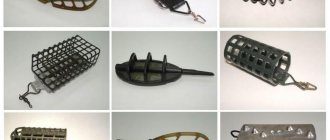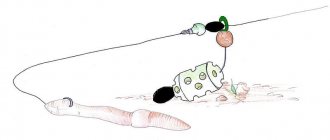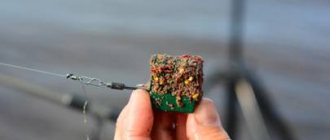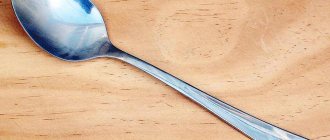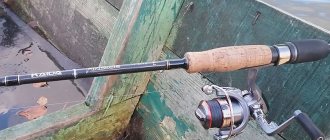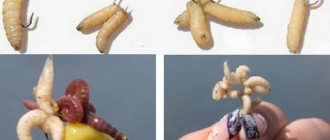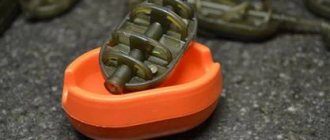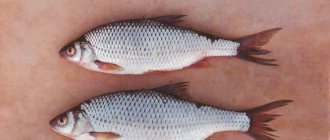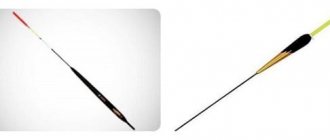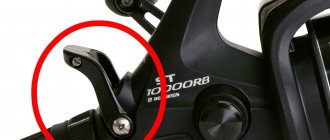Fishermen who hope to catch a trophy prefer to fish with a feeder, considering this equipment to be universal and effective.
A feeder rod is used to fish sections of a reservoir at different distances and at different depths. Fishing in large bodies of water is quite an exciting process that brings a lot of positive emotions.
However, feeders, especially on fast-flowing rivers, are often carried away by the current from the bait spot. In this situation, a real salvation will be the use of special feeder feeders designed for fishing in strong currents.
Features of feeder fishing in strong currents
There are 2 options for fishing reservoirs with strong currents. The fisherman can:
- start installing a feeder that the current will not move from the baited spot;
- accept the fact that the feeder will be carried away by the current and fish a section of the river not on a baited spot, but on a baited trail (in this case, the feeder will need to be cast to the same point).
Both algorithms of action are absolutely clear. However, it is worth remembering that in the event of a strong drift of the line downstream, you will need to take care of increasing the weight of the load. To do this, you can hang additional weight on the feeder or install another structure. During the current, it is advisable to use feeders whose weight reaches 100-150 grams.
What to do to prevent the feeder from being carried away by the current
If the river current is too strong, the feeder will be carried too far from the feeding spot. In this case, it is advisable to take care of:
- installing another heavier feeder;
- changing the diameter of the fishing line/braid (you should give preference to thinner cords), which will help increase the stability of the feeder in the current;
- using a feeder with lugs;
Feeder with lug - reducing the fishing distance;
- moving to a place with shallower depth.
Installing a heavier feeder is considered the fastest and easiest way to cope with the current.
Note! Experienced fishermen advise that when fishing in the current, place the tackle as high as possible on the stand.
When installed on a rod-pod, when fishing on a feeder in a current, the rod should be placed as tilted up as possible
1. Use a heavier feeder weight
This is the first of the most effective ways. Most often, it is by taking a heavier feeder that you can cope with the current. But there is one big and one small obstacle. The first is the feeder test, and the second is the lack of a suitable feeder in stock.
If you are planning to fish in a current, and even a fast one, then you need to purchase a heavy, or even extra heavy, feeder. The popular test of a rod up to 120 grams is not the limit; with this casting you can only cast 100 gram feeders (don’t forget that you need to add the weight of the bait to its weight and try not to exceed this value). For many rivers, feeder rods with a test weight of 140-160 grams or more may be suitable.
Although such a powerful class of feeders can be more likely attributed to carp rods than to feeders. Although the tip will still give the feeder its “trademark” sensitivity, the fast action of the blank will no longer be able to convey those sensations when playing fish, which is why so many people love fishing with a feeder.
It is clear that in the stock of any feeder there should be feeders for both standing water (30-60 grams) and for flow (80-120 grams or more). If the required weight is not available, and the feeder test allows it, then you can add a small weight to the weight of the feeder. But such a design “holds the bottom” worse than a monolithic feeder of the same weight.
Here you need to step back and say that the weight of the feeder should be “on the verge”, that is, you should not fish with a feeder that is too heavy, the weight of which will be too high for a given current. Why is it important? The feeder tackle will be optimally tuned when the feeder moves away when a fish bites . This causes the fish to self-hatch, and when fishing in the current with a properly selected feeder (with balanced equipment), the angler very often only has to remove the fish. If you fish with a heavy feeder, then the fish’s bite will not be able to tear it from its place, and its “correct” self-hooking will not work.
Using heavy feeders can cause them to shoot more often and even damage the clip on some reels. To throw such weight on thin lines and cords without fear, you can use a shock leader on the feeder. It’s better to adjust the casting distance using the rubber band on the spool.
Which feeder feeders are used for fishing in strong currents?
Fishing stores offer a wide range of feeders for feeder fishing. Below you can see the most popular options for feeders, which are actively used in the process of fishing in the current.
X-feeder PL Glass Turbo Middle
The X-feeder PL Glass Turbo Middle has good flight characteristics. The presence of massive lugs allows the feeder to remain on the bottom surface, despite the strong current. The coating of the feeder is wear-resistant and resistant to mechanical damage.
Ivva Sport
Ivva Sport is a heavy feeder, weighing 100 grams. This model is perfect for casting over medium distances (no more than 80 meters).
The smooth base allows the bait mixture to be well compressed, ensuring gradual leaching of the feed. The outline of the structure is cylindrical. The mesh, made from steel strips, provides increased strength. The model is equipped with lugs (6 pcs.), thanks to which the feeder will not be carried away by the current.
FC Vegas Oval
FC Vegas Oval is a feeder that can be used for fishing standing reservoirs and rivers with strong currents. The design has a built-in swivel and is made of plastic. The manufacturer equipped the FC Vegas Oval with wings that improve aerodynamics. This model is often used for fishing in water bodies overgrown with underwater vegetation.
Rig Sport
The Rig Sport's design is cylindrical. The feeder is made of metal and reinforced with jumpers. There is a loop at the end to secure the cord.
The center of gravity is shifted. Thanks to this, the line does not twist while casting. The body part is painted black. The presence of lugs allows you to fish areas of reservoirs with strong currents.
Haldorado Big River
On the underside of the base there are 4 teeth that cling to the bottom surface and are held in one place, despite the current. The manufacturer makes the Haldorado Big River from steel, so this model is characterized by increased strength.
Current feeder Hook
The structure is made of plastic, lead. The quality of the product is good. Feeders weighing more than 60 grams have hooks. This model is durable and affordable.
Mikado
The square-shaped feeder is made of metal. There are lugs on the base. The semi-closed model can be used for fishing in still waters and rivers with strong currents.
Carpi Sport
The Sport feeder design allows you to successfully fish flowing rivers and small standing reservoirs. The aerodynamic shape of the feeder allows you to make precise casts over the longest distances.
Mikado Olive
The Mikado Olive feeder is round in shape. The diameter of the structure with the bottom reaches 32 mm. The product is made of metal, so you can be sure of the strength of Mikado Olive and a long service life.
FC Sport M
The model holds well at depth not only in standing reservoirs, but also in rivers with strong currents. The food is evenly distributed in the water column, which reduces the risk of overfeeding the fish. The manufacturer applied a layer of polymer coating to the surface of the structure, which is of high quality, which helps to increase its service life.
How to choose a feeder for strong currents:
Feeders with lugs
Experts have developed feeder feeders with lugs designed for fishing in reservoirs with strong currents. The shape of such a design is most often rectangular or cylindrical. The base is flat with spikes, which help the feeder to stay at the fishing point. Among the best models with lugs, it is worth highlighting the feeders - Mikado, GRIZZLY XL, Brain River.
Note! The lugs are called the legs in the feeder. A device with spikes on the base, whose weight is 40-50 grams, is capable of resisting water flows, like models weighing more than 100-110 grams.
Grouser feeders for fast rivers are the best choice
How to make a river feeder with your own hands
You can purchase a food container at a fishing store or make it yourself. To make your own feeder, you will need to take care of the preparation in advance:
- galvanized mesh;
- lead (thickness 2–3 mm);
- metal scissors;
- wire (0.7 mm);
- wire (1.5 mm);
- sewed;
- soldering iron;
- tin.
Homemade Feeders
Step by Step Process
- First of all, a blank is made from the mesh. The cell size should be 3x12. The result should be a feeder, the size of which reaches 3x3x2.5 cm.
- Sharp edges are bent into the structure.
- The product is given the outline of a loaf in section.
- Using a soldering iron, solder 0.7 mm wire around the perimeter of the structure.
- A frame is made from 1.5 mm wire, the size of which will be 55 × 16 mm.
- After this, a swivel is installed and a lead base is made (4.3x2.5 cm).
- When bending it, you need to pay attention so that the ends meet at the junction with the middle of the feeder (along the outside).
- Then they make holes for the frame, place its ends along the length of the bottom of the feeder and clamp it with a plate with a frame using pliers.
- The joints are soldered. Grousers are made from tin on the bottom surface.
If you make a feeder for feeder fishing correctly, it will perform its functions no worse than store-bought options.
How to make feeder feeders for strong currents with your own hands from scrap materials:
Choosing gear for feeder fishing on the current
Of course, the equipment is chosen depending on the conditions in which fishing is carried out and, accordingly, if the desired prey is a large predator, then the equipment should be stronger and vice versa.
The required equipment is:
A fishing line that is used as a base.
She must be:
- monofilament and have a thickness of 0.2 - 0.24 millimeters;
- Don't stretch and be rigid.
The most popular manufacturers are Shimano (from 1000 rubles) and Trabucco (over 400 rubles).
Flood made of priority material fluorocarbon. Fluorocarbon leaders are made from a combination of fluorine and carbon. This material is recommended for use in the case of suspicious fish that are afraid of being caught; it is transparent and almost invisible.
Disadvantages may be the large diameter, which does not have the declared properties.
The advantages can be noted:
- Transparency and invisibility;
- Minimum time for immersion in water;
- Can be used at any temperature;
- Maintains appearance.
The diameter of the material depends directly on the weight of the fish.
For example:
- 0.16 mm – 1.5 kg;
- 0.31 more than 5 kilograms.
The best manufacturers are Pontoon (from 500 rubles) and Owner (up to 400 rubles).
- A swivel that fits the size of the feeder, the most popular colors are dark, they will not scare off the fish with their brightness;
- The hooks must not break or unbend;
- The feeder must be matched to the feed, for example, an open one is used when the feed should be scattered pointwise in place, while a closed one is used for bulk feed.
In addition, it must meet the requirements:
- Capacity. More than 2 kilograms of bait should be placed in the feeder;
- Fastening. Fixing the feeder must be done with a fishing line with a large diameter.
- Cell size. It must correspond to the current; the lower the current, the larger the cells.
- Load, preferably over 2 kilograms.
- Material.
There is no specific recommendation for the material; fishermen make their own from:
- Bag for vegetables and fruits;
- Metal;
- Plastic bottles.
Equipment and installation of feeder for flow
To fish areas of a reservoir with a strong current, you will need a heavy feeder. It is best to give preference to models with carbon fiber tips that can withstand the casting of massive equipment.
The length of the rod for an extra-heavy class feeder should reach 3.9 – 4.2 meters, and the test weight should exceed 120 grams. The best gear for fishing in currents is:
- Zemex RIVER Super Feeder;
- Golden Catch Onnex River Feeder;
- Kalipso Titan Feeder;
- Rampage River Feeder.
When choosing a reel, you should give preference to designs with a baitrunner. The spool size should be between 3000-5000. The best reels in this category are:
- Fanatik Riga 5000;
- Salmo Elite Baitfeeder;
- GOSS KD.
The mass of the sinker is selected depending on the strength of the current. The recommended leash length is in the range of 15-90 cm. Most often, fishermen make leashes 40 cm long.
Feeder installation
- The knees of the tackle are joined so that the rings are located on the same line.
- The reel is secured to the rod using a screw/snap mechanism.
- The braid/line is passed through the rings and secured to the reel. The cord is wound and secured with a simple knot, leaving a small side (2 mm).
- After this, the feeder equipment and feeder are tied. Additionally, a titanium/tungsten leash equipped with a carabiner is attached.
The tackle is ready for use.
When choosing an equipment option, you should give preference to one of the following options:
- paternoster on the current;
- symmetrical loop;
- asymmetrical loop.
Paternoster with a feeder for using a feeder on the current.
Ease of installation and low risk of tangling the leash are considered the main advantages of the paternoster. Such equipment is actively used for fishing in rivers with strong currents and in standing reservoirs. Leashes should not be too short. The recommended leash length is 40-70 cm.
Symmetrical and asymmetrical loops are also often used by feeders when fishing in the current. This type of equipment is characterized by increased sensitivity.
Feeder feeders for currents, what is “vampire” and “duplex” - video review of reels for fast rivers:
Symmetrical and asymmetrical loops for flow
These rigs are very similar in manufacturing, the only difference being the proportion of the arms of the loop itself. Probably everyone has heard about the high sensitivity of feeder gear when using “asymmetry”. Many people prefer this equipment precisely because of this, although they have to spend time tying it, and at the beginning of mastering feeder fishing, this time may not be short. But what can compare with almost one hundred percent transmission of even the slightest bite to the tip of the feeder?
But during the current, the loop rig may not please the angler at all. Many people abandoned the loop precisely because of the frequent overlaps of the leash. Those fishermen who have “made friends” with such equipment are surprised to hear about overlaps and tangling of the equipment. As always, there are so many people and so many opinions. But the fact remains that in currents, and even strong ones, overlaps occur more often, especially if the cast is not stopped by the reel clip.
Moreover, for some fishermen, it is the asymmetrical loop that gets more tangled and the retracting leash quickly loses its “retracting” properties. I don’t know why this happens, but a symmetrical loop, despite its similarity to “asymmetry,” sometimes shows better qualities in the flow. The deformation of the diverting leash occurs more slowly and, accordingly, the leash tangles less frequently. But again, this is everyone’s personal experience and much depends on the characteristics of the river bottom and current.
An asymmetrical loop on the feeder will show a bite when the fish pulls the bait in almost any direction, and if there are no problems with overlaps, then it makes no sense to limit yourself in the sensitivity of the tackle by using a paternoster or a symmetrical loop. When catching small fish and a sluggish bite, it is the sensitivity of the equipment that can play an important role.
Tips and secrets for fishing in strong currents with a feeder
Experienced fishermen are always ready to share their fishing secrets with beginners. Below you can find advice from experienced fishermen regarding feeder fishing in strong currents.
- A quick and fairly effective way to increase the resistance of the feeder to the force of the current is to change its mass. If the current carries away 70 grams of the structure, you should install a feeder weighing 100-120 grams.
- When fishing an area of a reservoir with a strong current, it is worth throwing the bait closer to the shore, where the strength of the current is slightly weaker.
- By changing the shape of the feeder, you can determine which one is less likely to be carried away by the current. Experienced fishermen recommend using round/cylindrical products, designs with hooks and a flat bottom.
- When going to a body of water with a strong current, it is worth putting a rigid tip on the tackle.
Regardless of which method of fishing in a body of water with a strong current is used by the angler, it is important to take care of the correct installation of the gear and the selection of a suitable feeder. After reviewing the rating of the best designs, you can choose the most suitable option for yourself. No tail, no scales!
Fishing with a feeder on ponds, choosing a feeder and method of installing equipment
Feeder
When fishing with a picker, especially on a rod with a weight of up to 20 grams, weights are often used instead of feeders, since even if a plastic feeder is loaded with bait, its weight will exceed the feeder’s limit test . In this case, the starting feeding is carried out manually (if distance allows), using a slingshot or a more powerful rod. You can also throw a marker float nearby, feed and catch, focusing on it.
As for the feeders themselves, when fishing with a feeder on a pond, you must take into account that in most cases their bottom is covered with silt, some have more, others have less. When fishing on a reservoir with a heavily silted bottom, it is preferable to use a wide, flat feeder with a light weight. As an option, the “Method” or a plastic round mesh feeder with wings . Also, when fishing at shallow depths, you can attach a piece of polyurethane to the feeder so that it sinks, but very slowly. Such a feeder will reach the bottom due to the inertia and weight of the bait, but gradually freeing itself from food and having almost neutral buoyancy, it will not sink into silt. When fishing with weights, it is effective to impart buoyancy not to the weight, but to the hook, for which we attach a piece of foam plastic or other buoyant material to it. Another good solution would be to use a floating Corn puff bait.
If, when casting, the feeder does not get stuck in the silt, then you can use ordinary cylindrical cage-type feeders.
Feeders for feeder fishing on ponds are selected based on their weight so that when you cast the tackle, the feeder falls to the bottom and you pull the line; your tip can take an average position between a flat tip and a tip bent at an angle of 90 degrees.
In this case, the feeder should not budge.
Fishing with a feeder on ponds, installation of equipment
Equipment using an open feeder “Method” . It is very effective in carp fishing because it is easy to hide baited hooks in it, using it as a nipple. There are two ways to attach the feeder: blind and inline. Blind installation is self-cutting.
Paternoster (Gardner's loop) - suitable for both current and still water bodies, very sensitive, often the fish sits tightly on the hook even without hooking.
Symmetrical and asymmetrical loops are self-cutting equipment. Fishing with a feeder on a pond using an asymmetrical loop has a number of advantages over symmetry; when casting, there is less chance of the leashes overlapping,
In addition, it has better sensitivity, but the use of symmetry is not recommended in cases where there is a large amount of snags or other rubbish at the bottom.
Inline (running feeder) is an excellent option when fishing close to the shore; when casting far away, the likelihood of overlap increases
